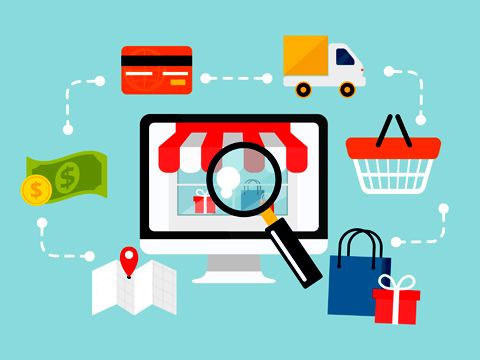E-commerce, short for electronic commerce, refers to the buying and selling of goods or services over the internet. It has transformed the way businesses operate and has given rise to an entirely new ecosystem of online transactions. From small startups to massive multinational corporations, e-commerce has opened doors for businesses of all sizes to reach customers globally. This article delves into the world of e-commerce, exploring its history, types, benefits, challenges, and future trends.
The Evolution of E-commerce
E-commerce’s journey began in the early 1990s, thanks to the development of the internet and the advent of secure online payment systems. In 1991, the National Science Foundation lifted the ban on commercial use of the internet, allowing businesses to create websites and conduct transactions. This was a pivotal moment in the history of online commerce.
The first major success story in e-commerce was Amazon, founded by Jeff Bezos in 1994. Initially an online bookstore, Amazon expanded rapidly into a multi-billion-dollar company offering a wide range of products. eBay, founded in 1995, followed suit by offering an online marketplace for auctions. These companies revolutionized online shopping, and soon, many others joined the race.
Types of E-commerce
E-commerce can be classified into several categories based on the type of transaction and participants involved. The main types include:
- Business to Consumer (B2C): B2C is the most common type of e-commerce. In this model, businesses sell products or services directly to individual consumers. Websites like Amazon, Walmart, and Zappos are prime examples of B2C platforms. Customers can browse through a variety of products, compare prices, read reviews, and make purchases online. The B2C model is driven by convenience, as consumers can shop from the comfort of their homes.
- Business to Business (B2B): B2B e-commerce refers to transactions between businesses, such as manufacturers selling products to wholesalers, or wholesalers selling to retailers. B2B platforms like Alibaba and ThomasNet facilitate bulk purchases and supply chain transactions. These platforms are often characterized by larger order volumes, longer sales cycles, and customized agreements between businesses.
- Consumer to Consumer (C2C): C2C e-commerce involves transactions between individual consumers. Platforms like eBay, Craigslist, and Poshmark provide a marketplace where individuals can buy and sell products directly to each other. This model has gained traction due to its low entry barrier and the ability for users to sell pre-owned items.
- Consumer to Business (C2B): In a C2B model, individual consumers offer products or services to businesses. This is a less common model but has grown in the form of crowdsourcing, freelance work, and influencers. For example, photographers selling stock images or freelancers providing services on platforms like Upwork are examples of C2B transactions.
- Business to Government (B2G): B2G e-commerce involves transactions between businesses and government entities. These transactions typically include providing goods or services to the government through formal bidding processes. Companies that supply office equipment, construction materials, or software to government agencies are part of the B2G ecosystem.
The Benefits of E-commerce
E-commerce offers numerous advantages to both businesses and consumers. Below are some of the key benefits:
- Global Reach: One of the most significant advantages of e-commerce is its ability to connect businesses with customers across the world. No longer are businesses limited to their local markets; with a strong online presence, they can reach a global customer base. This is particularly valuable for small businesses looking to expand beyond their local geography.
- Convenience: For consumers, shopping online is extremely convenient. E-commerce allows customers to browse products 24/7, compare prices, read reviews, and make purchases at their convenience. The ease of online shopping eliminates the need for physical store visits, saving time and energy.
- Cost-Effectiveness: E-commerce enables businesses to reduce operational costs. Without the need for physical storefronts, businesses can save on rent, utilities, and other overhead costs. Additionally, e-commerce platforms often provide businesses with tools to automate processes like inventory management and marketing, reducing the need for manual intervention.
- Personalization: E-commerce platforms leverage customer data and artificial intelligence to offer personalized shopping experiences. Websites track customer behavior, such as browsing history and past purchases, to recommend products that align with their preferences. This creates a more tailored experience, increasing the likelihood of conversion and customer loyalty.
- Easy Marketing and Analytics: E-commerce businesses can track consumer behavior in real-time through data analytics. They can monitor how visitors navigate their site, which products are most popular, and how effective their marketing campaigns are. This data-driven approach enables businesses to make informed decisions about product offerings, pricing strategies, and marketing efforts.
Challenges Faced by E-commerce
Despite its many benefits, e-commerce also comes with its own set of challenges. These include:
- Security Concerns: One of the most significant concerns for both businesses and consumers is the issue of online security. The rise in cybercrime, data breaches, and identity theft has made consumers wary of sharing personal and financial information online. E-commerce businesses must invest in secure payment gateways and encryption technologies to protect their customers’ data.
- Competition: The online marketplace is highly competitive. Businesses must differentiate themselves by offering superior customer service, unique product offerings, or competitive prices. In saturated markets, standing out can be a daunting task, and businesses must constantly innovate to stay ahead.
- Shipping and Logistics: Efficient shipping and logistics are crucial to the success of an e-commerce business. Delays in delivery, damaged goods, or high shipping costs can result in dissatisfied customers and lost sales. Businesses must work with reliable shipping partners to ensure timely deliveries and optimize shipping costs.
- Customer Trust and Satisfaction: Building trust is an ongoing challenge for e-commerce businesses. Customers often rely on reviews and ratings to determine the credibility of a seller. Negative reviews or poor customer service can tarnish a business’s reputation, making it crucial to maintain high-quality products and excellent customer support.
The Future of E-commerce
The e-commerce landscape is constantly evolving. Emerging technologies are shaping the future of online shopping and business operations. Here are some trends to watch for:
- Artificial Intelligence (AI) and Automation: AI and automation are transforming e-commerce by improving customer experiences and streamlining operations. From chatbots providing instant customer support to automated warehouses for faster order fulfillment, AI has the potential to enhance nearly every aspect of e-commerce.
- Mobile Commerce: With the increasing use of smartphones, mobile commerce (m-commerce) is expected to continue growing. Optimized mobile shopping experiences, mobile wallets, and in-app purchases are becoming standard for many e-commerce businesses.
- Augmented Reality (AR): Augmented reality is poised to revolutionize the online shopping experience. AR allows consumers to visualize products in their real-life environment before making a purchase. For instance, customers can see how a piece of furniture looks in their living room or try on clothes virtually.
- Sustainability: As consumers become more eco-conscious, e-commerce businesses will need to adopt sustainable practices. This includes reducing packaging waste, sourcing products responsibly, and implementing green supply chain practices.
- Voice Commerce: Voice-activated devices like Amazon’s Alexa and Google Assistant are opening the door for voice commerce. Consumers can now make purchases simply by speaking, providing an even more seamless and hands-free shopping experience.
Conclusion
E-commerce has radically transformed the way people shop and do business. From offering unmatched convenience to creating new opportunities for businesses, e-commerce continues to evolve, driven by advancements in technology and changing consumer preferences. Despite its challenges, the future of e-commerce looks promising, with new trends and innovations constantly reshaping the digital marketplace. As businesses continue to embrace e-commerce, it will remain a critical component of the global economy for years to come.






Leave a Reply